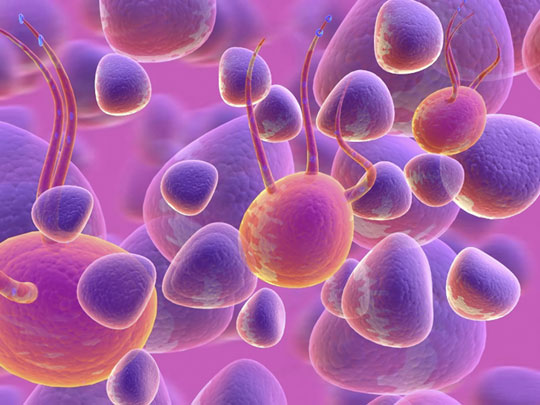Human brain stem cells
Human brain stem cells, after being implanted in the brain of newborn babies, can develop and act like mouse brain cells.

Image for illustrative purposes. (Internet source)
This new breakthrough offers the potential for treatment for patients with brain damage such as epilepsy or Parkinson's, using the patient's own brain stem cells, according to New Scientist magazine.
The key to the study was made by experts Steven Roper and Dennis Steindler of the University of Florida in Gainesville, USA, that adult stem cells can develop into all kinds of brain tissue in mice, including the shell. brain and hippocampus, brain region involved in memory function and spatial awareness.
Roper expert extracted adult stem cells from the brain tissue of a young woman with epilepsy. He and his partner Steindler then cloned in the laboratory and genetically modified these cells so they could glow green under ultraviolet light.
Next, newly formed cells are injected into the brain of newborn babies. After 3 weeks, the researchers examined the brains of these mice and found that the entire mouse brain is green cells.
According to Roper, transplanted cells have grown into neurons that are compatible with every part of the brain they attach to.
The two researchers also discovered that these cells are fully functional and can signal to the neurons of mice, through experiments to monitor the electrical activity of the cells. done in the lab.
This new discovery has great potential for human application. Roper said, it is possible to isolate stem cells from diseased tissue of brain-damaged patients when they undergo surgery, then perform cloning in the laboratory and turn them into cell types. need for the patient and bring it back into his or her brain.
- Create tiny brain from human skin
- Successfully created artificial brain like 99% real brain
- Stem cells in human bones can renew themselves
- Transform human skin cells into brain cells
- Successfully created kidney cells from stem cells
- Awakening 'dormant' cells helps the brain heal itself
- Experimental injection of stem cells to prevent glass bone disease
- 10 ways stem cells promote medical development
- New method to create human stem cells
- Breakthrough to reproduce the human system
- Stem cells will be taken to the ISS station for observation
- Use stem cells of human blood to kill HIV
 Green tea cleans teeth better than mouthwash?
Green tea cleans teeth better than mouthwash? Death kiss: This is why you should not let anyone kiss your baby's lips
Death kiss: This is why you should not let anyone kiss your baby's lips What is salmonellosis?
What is salmonellosis? Caution should be exercised when using aloe vera through eating and drinking
Caution should be exercised when using aloe vera through eating and drinking Does exercising our minds a lot help us burn excess calories?
Does exercising our minds a lot help us burn excess calories?  How did Egyptian mummies remove the brain from the body?
How did Egyptian mummies remove the brain from the body?  Shocking evidence that near-death experiences are real in people who have had cardiac arrest
Shocking evidence that near-death experiences are real in people who have had cardiac arrest  AI has been able to accurately reproduce more than 80% of images in the human brain.
AI has been able to accurately reproduce more than 80% of images in the human brain.  Neuralink tests controlling a robotic arm with thoughts
Neuralink tests controlling a robotic arm with thoughts  Elon Musk's ambition to merge humans with AI
Elon Musk's ambition to merge humans with AI 